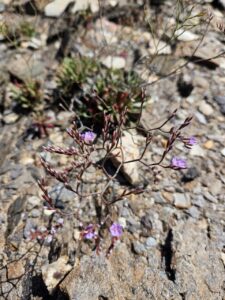

Limonium tremolsii starting to blossom.
In today’s section of THE FEATURED PLANT, we talk about the Sea-lavender or Statice, the two threatened species in Costa Brava to be more accurate, Limonium geronense Erben and Limonium tremolsii (Rouy) Erben. These are perennial plants with a short and woody stem, and long leaves with rounded tips, faintly fleshy that sometimes become reddish. Now during the first months of summer, they start blooming. You can spot them by their inflorescences of thin stems branching out and ending with lines of flowers with five petals, of a pale purple turning whitish once the petals have fallen and only the papery sepals, with a rusty brown middle nerve, remain.
Like many other sea-lavenders of our land, they grow on rocky zones with shallow soils, and thanks to that and their ability to withstand salinity fairly we usually find them growing out of cliffs. At first glance, they may seem the same but they have, in fact, some distinctions quite hard to see to the naked eye. The most apparent difference is that Limonium geronense has a mucron, like a hair, growing at the tip of the leaf, and their flowers are more spread along the branch and less compacted. It grows exclusively in the Cape of Creus, making it endemic to this area so it cannot be found elsewhere.

Sea-lavender growing among pebbles (Limonium tremolsii)
Sea-lavenders status
Both species are mentioned in the Red List of Vascular Flora of Spain, Limonium geronense as vulnerable (VU according to the IUCN classification) and L. tremolsii as nearly threatened (NT according to the IUCN classification). They never form great extensions as they grow slowly and live in zones of little soil. They tend to live among the company of other, more abundant, littoral species, such as Crithmum maritimum, Polycarpon polycarpoides, Daucus gingidium, Jacobea marítima, Helichrysum stoechas, Salsola vermiculata and Limbarda crithmoides. These species are threatened, or nearly so, due to their size, growth and dispersion rate. They are easily displaced by other, more vigorous, plants that arrive in the region. These invasive species usually behave more aggressively towards the local surrounding plant species, either because they cover the soil and do not let light pass through or because they spread and grow faster than the autochthonous species.

Sea-lavender growing between the stems of a Carpobrotus sp
This issue comes from an anthropic origin, since if it was by natural means, the plants of one region that live together coevolve and the populations regulate themselves until they reach a state of balance. The problem is that these plants have arrived, brought by men, and have not coevolved with the local species. There is also the extra fact that they are aesthetically pretty, which attracts people and makes them want to plant more and then, some plants spread out of the gardens by their own means or by cuttings of pruning. As the climate matches the same of the plant’s origin, these can become naturalized easily and replace the local species by outcompeting them. Moreover, culturally, the knowledge of the local species like the sea-lavenders is fading caused of the increase of more flashing flowers that attract the eyesight overshadowing the smaller and more inconspicuous plants, which people are not conscious of their disappearance.

Sea-lavender engulfed in a carpet of Drosanthemum floribundum showing dry branches of old inflorescences.
How can we see the sea-lavenders?
During the project, we have asked the citizens about their knowledge of these plants, as well as the three main invasive species, which we are monitoring clearing works on: the prickly pear or Indian fig opuntia (Opuntia ficus-indica), the sour figs or hottentot-figs (Carpobrotus spp.) and the treasure flower (Gazania rigens). We have seen that in general, many people ignore the sea-lavenders compared to the invasive species, especially because of their smaller flowers and fruits compared to the bigger and brighter ones of the invasive species. For this reason, we encourage you all to go outside, enjoy these shiny months and good weather, visit the Costa Brava and observe the ephemeral purple flowers of the sea-lavenders, now when you can see them at their best than any other moment of the year. And, if you get there too early, you might be able to see some rusty branches of last year’s blossom.

Limonium geronense growing out of a crevice next to a Gazania rigens.
Remember, as they grow in rocky areas be careful, safety first. If you visit the Natural Park of Cap de Creus please respect the pathways and do not step out. You will easily see several specimens from there. There is also the possibility that you may find other Limonium species! In Catalonia, there are about 18 species of sea-lavenders, and there are also some which grow on lime soils so you can find them along the Costa Daurada.



